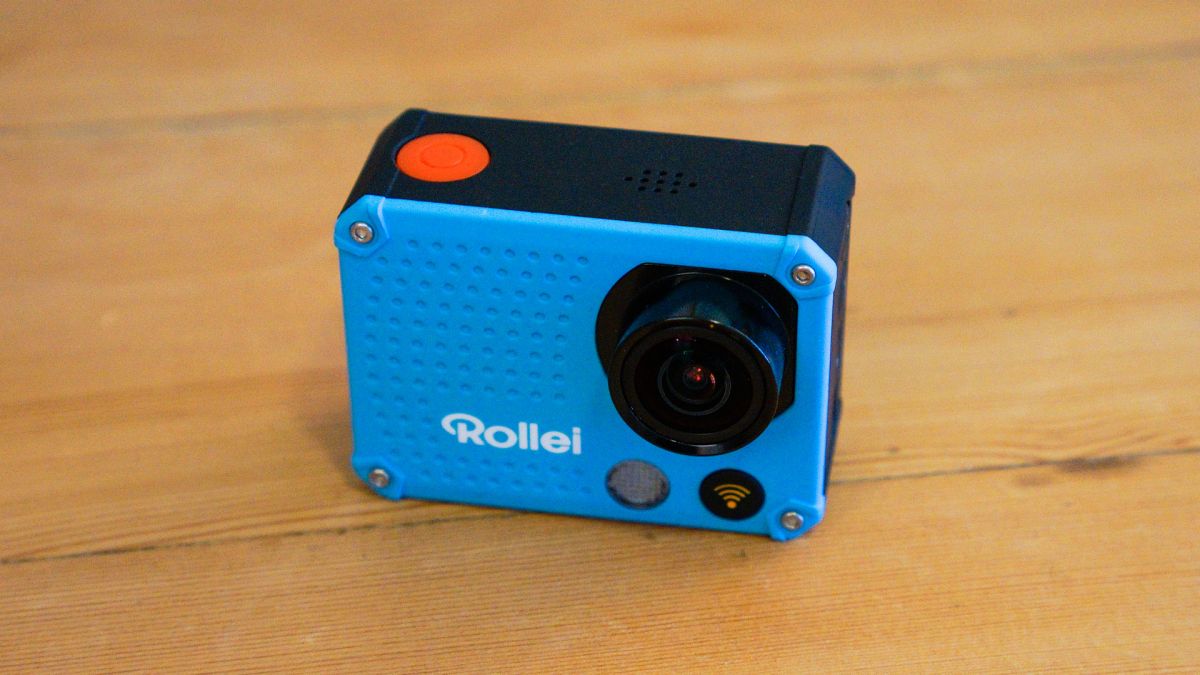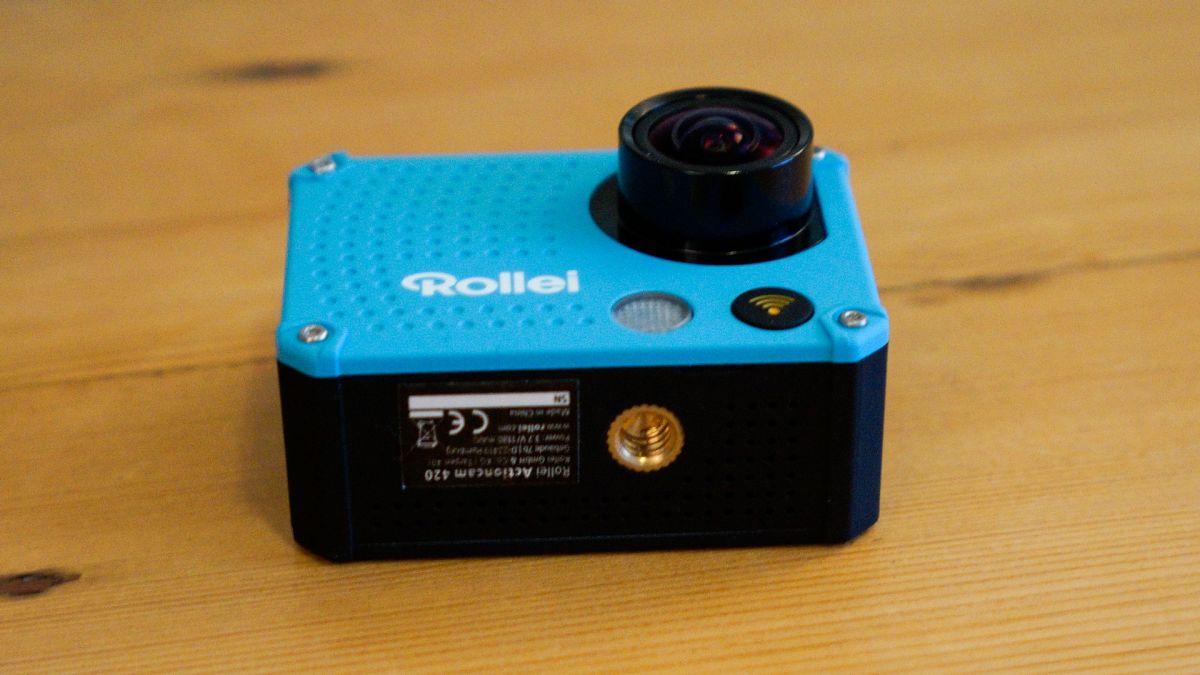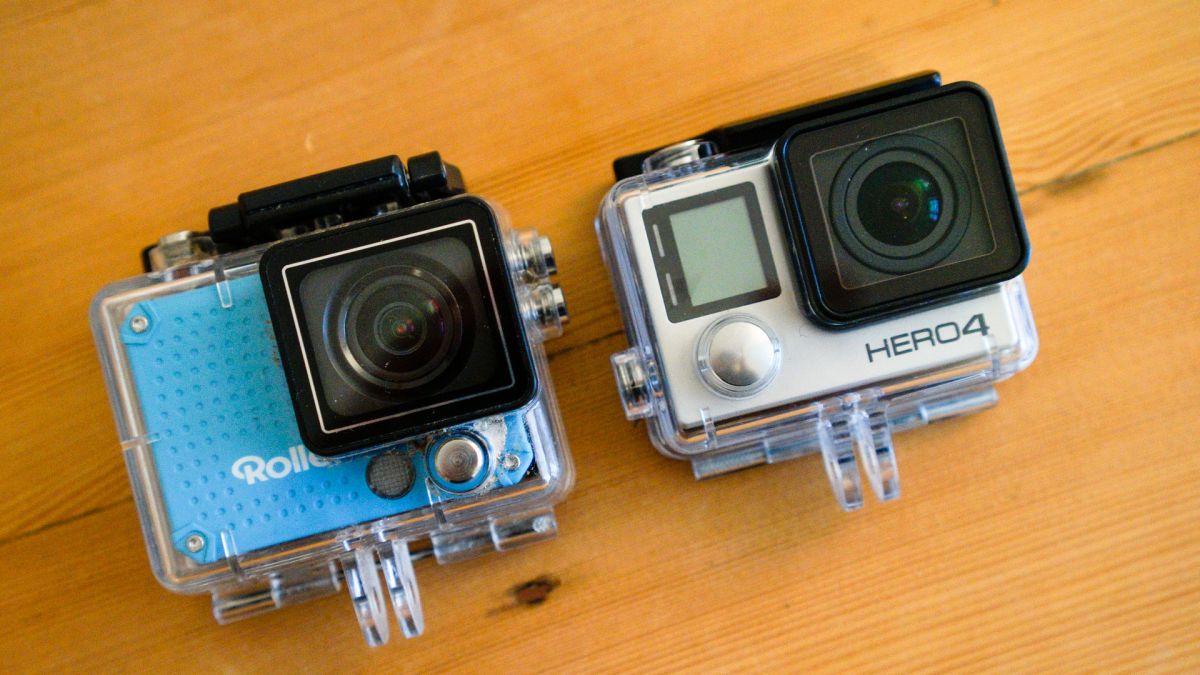Introduction and handling
Rollei’s Actioncam 402 is in essence an oversized GoPro with the familiar box design encased in a waterproof housing. Making sure the 420 stands out in a crowded market, Rollei offers the camera in three colours: black, blue or white. It is also one of the only budget cameras to offer a flat lens on the housing with no screws or indents, which means that it’s easy to clean and instantly wins affection.
4K is the big headline feature and this is joined by plenty of other resolutions and frame rates, including full HD at 60fps and 720p at 120fps; perfect for capturing slow motion footage. The front of the camera features a small f/2.5 lens with a 170-degree field of view.
The 420 also offers a variety of modes alongside video. including Photo, time-lapse, slow motion, Driving and Motion detection, giving you plenty of options. Wi-Fi is supported by an app for Android and iOS and this is very neat and simple, enabling the usual live view and settings adjustments. The larger size of the 420 also means that it has a decent-sized 2-inch LCD on the back.
Powering the camera is a 3.7v 1180mAh battery that supplies enough charge for almost two hours of continual use, though this battery is sealed and is not interchangeable. The base also features a very handy standard tripod mount so the camera can easily be removed from the case and mounted on a tripod without the need for additional accessories.
Build and handling
The camera is extremely well built with the rubberized exterior giving a really nice finish. All buttons are equally well finished and feature small icons that clearly show the function of each button.


Without the case, the camera is a very nice piece of kit to use, just slightly larger than a GoPro. The exterior features four buttons which are intuitively laid out. Push the shutter button and the camera switches on, you push it again to start recording. On the front is the Wi-Fi activation button, while on the side are the up and down navigation buttons with the shutter button being used to confirm selections. Below these two buttons are the USB 2 type B and HDMI micro connectors.
Once the camera is connected to a mobile device, the app also enables the adjustment of settings, yet it only allows a relatively limited number of adjustments compared with the direct in camera options. When using Wi-Fi the camera defaults to 1080p with a choice of either 60, 30 or 25fps; when the app is in use there is no access to any other resolutions or frame rates.

The camera is designed to sit within the supplied waterproof housing and this features a nice flat, easy-clean lens, a GoPro style mount on the base and a lever lock door to make sure the housing stays sealed. This style of lock is a little dated and can be fiddly to open and close and the secondary lock can become jammed in muddy conditions The case offers a good level of protection and has a 40m waterproof rating.
In use the housing provided excellent protection for the camera, and the flat lens was ideal for the muddy testing conditions. The only issue was that of the small secondary lock on the lever. After a few hours in the mud this became well and truly jammed, and required a good wash under a tap to enable it to be released.
Performance and verdict
Video options through the camera are accessed by holding down the up navigation button. Options for Movie Size and Video Quality are at the top of the menu which is handy, and below these are a series of other modes , notably Time-Lapse and Motion detection – which starts recording when motion is detected. There are also a few more advanced options that enable you to adjust the white balance and exposure.
Connecting through the app offers far fewer options for adjusting settings but does enable you to quickly start recording remotely and switch to the stills and time-lapse modes.
To make the most of resolutions such as 4K and 720p at 120fps you need to select these options directly through the camera, which is a annoying.
Video quality
The 4K video is limited to just 10fps but the quality is excellent with a good amount of detail, balanced contrast and good tonal graduation. The lens does suffer from flare when pointed directly into sunlight but generally produces good, clean footage.
• This footage shows a static shot from the Rollei ActionCam 420 taken at full HD 60 fps.
• When the camera is pointed away from the sun to avoid glare the 4K footage looks excellent. However, in this scene you can however see that the camera is burning out highlights in the sky on the left and right of the frame.
• The camera shows fantastic detail and visual quality at 4K, but here we can see signs of flare caused by the case.
• Motion is smooth even at 30 fps as with this footage. However even with the movie quality set to high the image shows signs of pixelation and there is a lack of overall detail.
• Direct comparison between the Rollei Actioncam 420 and the GoPro Hero4 black at 1080p 30fps.
Switching the resolution of the camera to 1080p at 30fps the quality of footage reduces dramatically, with a loss of detail and sudden boost in contrast which is in stark contrast to the quality of the 4K footage. Further reducing the resolution down to 720p drops the quality of the video still further with even more loss of detail.
Initially the Rollei Actioncam 420 looks like a good deal. It looks great and the camera and case are decent enough quality. However, as you dip into the menus and settings it quickly becomes apparent that the full potential of this camera really isn’t being realised.
Small design features such as the flat lens on the housing and the simple clearly defined buttons and navigation show that thought has been put into the layout, but there are just too many compromises elsewhere with video quality and the app. If you want a camera that shoots excellent 4k video and you’re happy with a frame rate of 10fps, then this camera could be for you. Otherwise are plenty of far better options.

We liked
Overall build quality is good and the option to select one of three colours for the camera is a small but welcome feature. The inclusion of a standard tripod thread at the base of the camera is a nice touch as is the large LCD screen. Navigation has been well thought out and finding your way around is exceptionally easy. The 4K video might be limited to just 10fps but the quality is exceptional.
We disliked
After a muddy ride the lever lock that secures the case closed was near impossible to open and in normal conditions and was fiddly to use. Video quality was the biggest let down and footage shot at 1080p at all frame rates was in stark contrast to the high quality footage shot at 4K. In some ways the slightly larger design did have its advantages when it came to handling the camera, but when the camera is mounted on a board or bike the additional size does mean that the camera is far more likely to be knocked.
Final verdict
If the Full HD 1080p video had matched the quality of the 4K output then the 420 would have been an exception camera. However the high contrast and lack of detail at all but the 4K video settings are a huge disappointment.
The design follows that of the market leading GoPro but the small and seemingly insignificant increase in size does have an effect of where and how the camera can be successfully mounted. When compared side by side with competitors, that additional size really is highlighted.
If you’re after a 4K action camera then at present the market is very limited. If you need both quality and frame rate than at present there is still only one option – the GoPro Hero4 Black. Otherwise, at this price point and with similar specifications there’s the exception iSAW Edge or at half the price and if you don’t mind the older style case you have the SJCAM SJ5000X.
Source: techradar.com









